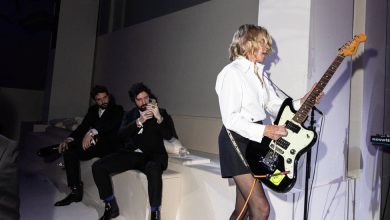The Design Legacy of Covid? It’s All Around You.

If you had to devise a single object to capture the twitchy fear and uncertainty that defined the early stage of the pandemic, you could do worse than the “no-touch door opener.” Available for delivery from Amazon for just a few bucks, this key-size piece of metal, curved into multiple prongs, looks like an artifact of some lost civilization. It purports to help you operate elevator buttons and open latches and poke your phone without touching any of them. This item was, at best, a silly response to what turned out to be an airborne virus. And yet at the same time it reflects something fundamental to the human experience: the urge to tinker and design and adapt in the face of crises large and small.
Some of those responses prove fleeting; others endure. In the immediate aftermath of 9/11, American airports bristled with armed soldiers. That went away, but the security procedures surrounding air travel were permanently transformed; it’s hard to explain to someone under 25 just how comparatively breezy movement through an airport used to be. Today, every time you toss your shoes into a plastic bin before boarding a plane — or submit to a biometric identification procedure to avoid that process — you are living in the designed legacy of a past crisis.
It’s fascinating to consider what the physical legacies of the pandemic might be. The most obvious example — the face mask, in its profusion of options and styles — was far from obvious at first. In April 2020, the chairman of Uniqlo’s parent company declared with confidence that the Tokyo-based retailer “will not sell masks.” In hindsight, that was an astonishing assertion, given that the cloth face mask would become the unavoidable icon of the era. After health authorities belatedly advised its widespread use, there were not enough to go around, and practically every apparel maker, from Gap to Louis Vuitton to countless independent sellers on Etsy, began selling face masks. This transition from exotic item to familiar one seemed to happen overnight.
In East Asia, previous viral outbreaks (SARS, H1N1, etc.) had already made masks a routine accessory for anyone feeling a bit under the weather, or just looking to avoid the seasonal flu. It’s now easy to imagine that behavior repeating across the metropoles of the United States and Europe — “essentially the normalizing of people wearing masks in everyday situations,” says Christian L’Orange, an assistant professor of mechanical engineering at Colorado State University, who has researched mask materials and effectiveness. For a generation of children, classroom use has made it familiar. “There has certainly been a huge increase in the number and style of masks that are available,” and significant improvements in the fabrics used by some makers of cloth masks, L’Orange continued; we now have studies showing that cloth masks with higher thread counts are better filters, and that masks combining a layer of cotton with another material layer can also be more effective.
One prime example, it turns out, is the line of masks Uniqlo wound up making. Citing customer demand, the company changed course in June 2020, selling a mask using a proprietary fabric that it previously used for, among other things, underwear. Its “AIRism” mesh material promised to be lighter and more breathable than cotton, enclosing a filter within layers comfortable to the skin. The mask was an immediate hit in Japan and rolled out worldwide, soon trendy enough to make Vogue and GQ and Hypebeast. By this past summer, the company signaled that masks would remain part of its permanent mix. “We believe there will continue to be a need for masks,” Uniqlo’s U.S. chief marketing officer told The Times in August, “and we have decided to offer the product year-round.” The mask’s surprising status as a divisive ideological symbol has obscured a more significant development: It has become a mainstream, quotidian object.
While the mask might seem, for better or worse, a kind of icon of the pandemic, this era is still redesigning our world. There may never be the kind of definitive end to Covid-19 that we all crave, no decisive before-and-after moment. But for nearly two years now, we’ve been gradually but steadily redesigning the world in response to this crisis. And whenever things get back to normal — whatever that looks like — our world will be full of these changes that, blatant or stealthy, will alter the texture of our lives.

Credit…Photo illustration by Derek Brahney
If the mask is a designed object we resisted and ultimately capitulated to, some pandemic design experiments may outlive the era because a significant number of people — or businesses — have actually welcomed and embraced them. Consider the way the early pandemic period absolutely brutalized the dining business. Even when regulations eased, restaurants large and small had to reassure customers of their safety. Seating arrangements were adjusted, staff masked up — and in many cases, menus disappeared, on the theory that people didn’t want to handle an object many others had touched. This ended up giving new life to a bit of information design that seemed to have peaked in the U.S. a decade or so ago: the QR code. Now you could wave your phone over one of these pixelated blobs and access a digital menu — and sometimes even order without talking to a server.
We now know that touching a menu is a highly unlikely way to contract the virus. But QR codes have proved sticky anyway. The reason is economic. Even before the pandemic, restaurants traditionally ran on very thin margins. The savings on printing costs alone are a significant incentive, but a digital menu could allow restaurants to nudge prices in real-time response to their own market costs. “QR codes have had this refresh, a new lease on life, because of Covid,” says Aaron Allen, a consultant in the hospitality industry. Millions of people finally learned how to interact with them; hotels and other businesses figured out how to use them to replace brochures and other print collateral. “What was probably going to fade away,” Allen says, “has become relevant in a way that will extend its life.”
But maybe not everywhere. Particularly at the higher end, the printed menu is one of the most conspicuous design platforms a restaurant has. “Better restaurants are going to be going back to real menus quite soon, because having that object in your hand is part of that greeting experience,” says Warren Ashworth, an architect and hospitality design expert. More value-focused eateries and chains will likely stick with the QR option that saves costs and time. So the way we react to the presence of a QR code may evolve accordingly. But we’ll know what it is — and it will be hard to explain that these interfaces used to be an overhyped curiosity with little practical value.
More significant, the normalization of the QR code as information-design surface has implications that transcend the restaurant and hospitality business, as designers figure out new ways to deploy it. Viewed expansively, QR is “a low-cost gateway” to information that can be constantly updated and adjusted, says Sandy Speicher, chief executive officer of the design firm IDEO. Retailers from Foot Locker to Macy’s have begun to use the codes as part of a touchless-payment option; small businesses such as hair salons use them for appointment check-ins, or to make it easier to tip barbers through Venmo. The familiarity and acceptance spread partly by restaurant (and patron) adaptation served as a sort of proof of concept for the form — a decade late. “That it scaled up that pervasively, that quickly, is remarkable,” Speicher says.
“Sometimes these emergencies become opportunities to create new baselines,” says Paola Antonelli, senior curator of architecture and design at MoMA. This is not always an intentional or conscious process, and the results can be troubling. The ways in which the aftermath of 9/11 helped reset baseline expectations around privacy and surveillance serve as a cautionary example. But, Antonelli says, the pandemic has perhaps established some positive new norms. This reflects another design side effect of the pandemic era: rapid experimentation, born of desperation.
There’s an argument to be made that the pandemic proved that research and innovation processes in the sciences and beyond need a refresh. Certainly it was remarkable, Antonelli points out, how quickly city governments moved to accommodate experiments like new bike lanes and allowing eateries to build outdoor spaces. Not everyone is a fan of those new structures, and it seems very likely that some kind of regulatory standards will emerge. But given the intense economic pressure to do something to help the restaurant industry and its workers, the new spaces came together with a speed that would have been “unthinkable” two years ago, says Ellen Fisher, vice president for academic affairs and dean at the New York School of Interior Design.
And Fisher believes the effects will last: “I think it’s really expanded the design vocabulary of the restaurant, what the boundaries are.” In a sense, she argues, it has returned the eatery to earlier roots as a center of community and gathering, “almost like a modern-day version of the plaza — like in Venice, the extension of the cafe into the square. I don’t think that’s ever going to go away.”
One place where this particular “design emergency,” as Antonelli calls it, has been most visible is the white-collar workplace. There has been much fevered speculation about the way offices might now be redesigned and re-envisioned to accommodate a “hybrid” model, with a chunk of employees opting to continue working from home a few days a week. Maybe desks will be configured differently, ending the reign of the widely loathed open-office scheme; maybe there will be even stranger developments. A company called Poppy is marketing a device that can monitor the air for traces of pathogens.
But so far, it’s the other side of the work-home dyad that has been more definitively redesigned. White-collar work has invaded the home, bringing office life into the domestic sphere in unprecedented ways. It’s now routine for office workers to reconsider some chunk of their home as a de facto studio. Early in the pandemic era, it was understandable if you checked into a digital meeting looking a bit ragged on your couch, or even opted to keep your video off. The fact that everyone was in the same position made such laxity possible; but once people are back in the office, and your video-connected colleagues are increasingly crisp-looking, well groomed and smartly lit, the calculus will be different.
And a whole ecosystem of products offers help. Logitech webcams now sell at triple the level they did two years ago. Sales of flattering “ring” lights — a halo of LED bulbs that smooth out shadows and minimize blemishes favored by social media influencers — are five times higher than they were a year ago, according to The NPD Group, a market research firm. In fact, the normalization of video distance by now transcends the workplace. Events from funerals to bar mitzvahs now accommodate video guests. Book readings and concerts and lectures have opened up to remote attendance. In education, distance learning transitioned from the experimental to a de facto standard practically overnight. (New York City has moved to end snow days, replacing them with remote learning — to the dismay of teachers and students alike.) Clearly, not all of these changes will stick. But just as clearly, a barrier has been breached, and the simple acceptability of video connection seems permanent — and significant.
Forcing such breaks may be the core legacy of the pandemic’s effect on design and innovation. It changed minds. For example: Phil Libin, a creator of the Evernote app and a founder of the product studio All Turtles, was among those who just wanted things to get back to the way they were. “I was an in-person kind of person,” he says. “I was a big proponent of fancy, nice offices.” In fact, what he didn’t like was video meetings. “I didn’t realize that the office was a central problem,” he continues. “Now I think it’s literally one of the dumbest ideas.”
Eventually, Libin shut down All Turtles’ physical offices and moved from San Francisco to northwest Arkansas. He and a few colleagues developed software designed to improve video presentations and calls, eventually building a whole new start-up called Mmhmm around it. “We used to be doing this totally wrong,” he says. “Why would I commute to an office, to sit in a cubicle and put on headphones to isolate myself from other people who had to commute to the office, so that I can get some work done? That makes zero sense.” The office made work inefficient, and interfered with life, he argues; the shift away from it is, in his eyes, “permanent.”
Looking back, Libin says the total rethink of the office is “one of the great silver linings of the pandemic.” It was remarkable how frequently some version of this sentiment came up in my conversations about the design legacies of the Covid-19 plague. In a way that seems distinct from other crisis periods in recent memory, there’s an overt determination to extract positive lessons from an emergency that has lasted so much longer than most of us thought it would.
This thought may be difficult to square with some of the implications of the designed responses to this crisis. The mass adoption of masks, and the general theme of increased distance, are frankly a little depressing. QR codes, for all their efficiency, further enable the personal-data tracking that was already one of the most vexing issues of modern life. And if it’s really true that virtual hybridity could become a routine component of the most momentous occasions in our lives — weddings, funerals and so on — then the startling and rather grim implication is that somehow we will grow comfortable spending even more time in front of our screens.
So how is it possible we might nevertheless emerge optimistic from this era? Maybe it’s simply because this particular crisis has been so slow and lasting: We’ve had time to learn that a no-touch door opener has a limited future, but that other changes have durable potential. And more than that, we’ve also had time to consider more deeply whether we can improve our workplaces, our cities — whether, after a decade of tech-centric thinking, we can have a more people-centric restart. Maybe this is a singular chance to reconsider how to make all our dazzling technologies work for us, rather than the other way around.
“If Covid happened five years ago, it could have been a very different experience,” Libin muses. “We’re very fortunate that underlying technology and platforms were good enough that we actually could do this kind of stuff. Maybe we wouldn’t really have been so ready to think about silver linings.”




